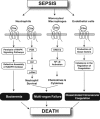Sepsis, complement and the dysregulated inflammatory response
- PMID: 19725914
- PMCID: PMC3087605
- DOI: 10.1111/j.1582-4934.2009.00893.x
Sepsis, complement and the dysregulated inflammatory response
Abstract
Sepsis in human beings is a major problem involving many individuals and with a high death rate. Except for a single drug (recombinant activated protein C) that has been approved for treatment of septic patients, supportive measures represent the main clinical approach. There are many models of experimental sepsis, mostly in rodents. A commonly used model is cecal ligation and puncture (CLP). In this model, robust activation of complement occurs together with up-regulation of C5a receptors (C5aR, C5L2) in a variety of different organs (lungs, kidneys, liver, heart). In septic human beings there is abundant evidence for complement activation. Interception of C5a or its receptors in the CLP model greatly improves survival in septic rodents. There is compelling evidence that CLP causes an intense pro-inflammatory state and that C5a interaction with its receptors can be linked to apoptosis of the lymphoid system and cells of the adrenal medulla, loss of innate immune functions of blood neutrophils, consumptive coagulopathy and cardiac dysfunction. These findings may have implications for therapeutic interventions in human beings with sepsis.
Figures




References
-
- Angus DC, Linde-Zwirble WT, Lidicker J, et al. Epidemiology of severe sepsis in the United States: analysis of incidence, outcome, and associated costs of care. Crit Care Med. 2001;29:1303–10. - PubMed
-
- Brun-Buisson C, Doyon F, Carlet J, et al. Incidence, risk factors, and outcome of severe sepsis and septic shock in adults. A multicenter prospective study in intensive care units. French ICU Group for Severe Sepsis. JAMA. 1995;274:968–74. - PubMed
-
- Friedman G, Silva E, Vincent JL. Has the mortality of septic shock changed with time. Crit Care Med. 1998;26:2078–86. - PubMed
-
- Martin GS, Mannino DM, Eaton S, et al. The epidemiology of sepsis in the United States from 1979 through 2000. N Engl J Med. 2003;348:1546–54. - PubMed
-
- Natanson C, Esposito CJ, Banks SM. The sirens’ songs of confirmatory sepsis trials: selection bias and sampling error. Crit Care Med. 1998;26:1927–31. - PubMed
Publication types
MeSH terms
Substances
Grants and funding
LinkOut - more resources
Full Text Sources
Medical
Miscellaneous

